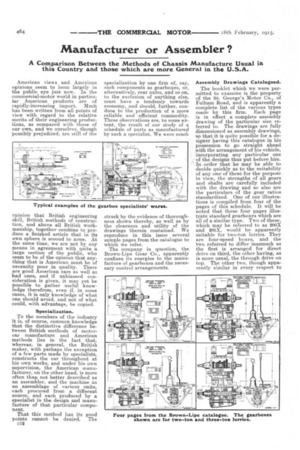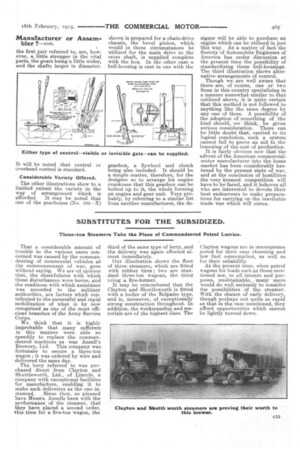Manufacturer or Assembler ?
Page 16

Page 17

If you've noticed an error in this article please click here to report it so we can fix it.
A Comparison Between the Methods of Chassis Manufacture Usual in this Country and those which are more General in the U.S.A.
American views and American opinions seem to loom largely in the public eye just now. In the commercial-motor world in particular American products are of rapidly-increasing import. Much has been written from all points of view with regard to the relative merits of their engineering productions, as compared with those of our own, and we ourselves, though possibly prejudiced, are still of the
opinion that British engineering skill, British methods of construe-. ben, and above all British workmanship, together combine to produce a finished article that in its own sphere. is second to none. At the same time, we are not by any means in agreement with quite a large section of the public, who seem to be of the opinion that anything that is American must be of necessity poor in quality. There are good American cars as well as bad ones, and if unbiassed consideratioa is given, it may yet be possible to gather useful knowledge therefrom, even if, in some cases, it is only knowledge of what one should avoid, and not of what could, with advantage, be copied.
Specialization.
To the members of the industry it is, of course, common knowledge that the distinctive difference between British methods of motorcar manufacture and American methods lies in the fact that, whereas, in general, the British maker, with perhaps the exception of a few parts made by specialists, constructs the car throughout at his own works, and under his own supervision, the American. manufacturer, on the other hand. is more often than not better described as an assembler, and the machine as an assemblage of various units, each procured from a different source, and each produced by a specialist in the design and manufacture of that particular component.
That this method has its good points cannot be denied. The c12 specialization by one firm of, say, such components as gearboxes, or, alternatively, rear axles, and so on, to the exclusion of anything else, • must have a tendency towards economy, and should, further, conduce to the production of a more reliable and efficient commodity. These observations are, to some extent, the result of our study of a schedule of parts as manufactured by such a specialist. We were much struck by the evidence of thoroughness shown thereby, as well as by the clearness and utility of the drawings therein contained. We reproduce in this issue several sample pages from the catalogue to which we refer.
The company in question, the Brown-Lipe Gear Co., apparently confines its energies to the manufacture of gearboxes and the necessary control arrangements. Assembly Drawings Catalogued.
The booklet which we were permitted to examine is the property of the St. George's Motor Co., of Fulham Road, and is apparently a complete list of the various types made by this firm. Each page is in effect a complete assembly drawing of the particular size referred to. The drawings are fully dimensioned as assembly drawings, so that it is quite possible for a designer having this catalogue in his possession to go straight ahead with the arrangement of his vehicle, incorporating any particular one of the designs thus put before him. In order that he may be able to decide quickly as to the suitability of any one of these for the purpoSe in view, the strengths of all gears and shafts are carefully included with the drawing and so also are the particulars of the gear ratios standardized. One of our illustrations is compiled from four of the pages of this schedule. It will be noted that these four pages illustrate standard gearboxes which are all of a similar type. Two of these, which may be referred to as 200X and 205X, would be apparently suitable for two-ton lorries. They are four-speed boxes, and the two referred to differ inasmuch as the first is arranged for direct drive on third, the other having, as is more usual, the through drive on top. The other two, though apparently similar in every respect to
Manufacturer or Assembler ?—con,
the first pair referred to, are, however, a little stronger in the vital parts, the gears being a little wider, and the shafts larger in diameter.
It will be noted that central or overhead control is standard.
Considerable Variety Offered.
The other illustrations show to a limited extent the variety in the way of arrangement which is afforded. It may be noted that one of the gearboxes (No. 184—X) shown is prepared for a chain-drive chassis, the bevel pinion, which would in these circumstances be utilized for the main drive to the cross shaft, is supplied complete with the box. In the other case a bell-housing is cast in one with the gearbox a flywheel and clutch being also included. It should be a simple matter, therefore, for the designer so to arrange his engine crankcase that this gearbox can be bolted up to it, the whole forming an engine and gear unit. Very probably, by referring to a similar list from another manufacturer, the de signer will be able to purchase an engine which can be utilized in just this way. As a matter of fact the Society of Automobile Engineers of America has under discussion at the present time the possibility of standardizing these bell-housings. The third illustration shows alternative arrangements of control.
Though we are well aware that there are, of course, one or two firms in this country specializing in a manner somewhat similar to that outlined above, it is quite certain that this method is not followed to anything like the same degree by any one of them. A possibility of the adoption of something of the kind should, we think, be given serious consideration. There can be little doubt that, carried to its logical conclusion, such a system cannot fail to prove an aid to the lessening of the cost of production. It is fairly obvious now that the advent of the American commercialmotor manufacturer into the home market has been considerably hastened by the present state of war, and at the conclusion of hostilities the very keenest competition will have to be faced, and it behoves all who are interested to devote their best endeavours to make preparations for carrying on the inevitable trade war which will ensue.




















